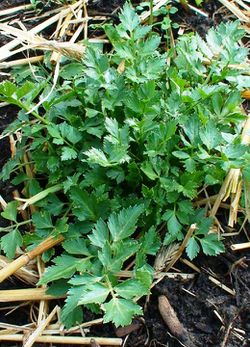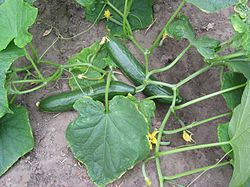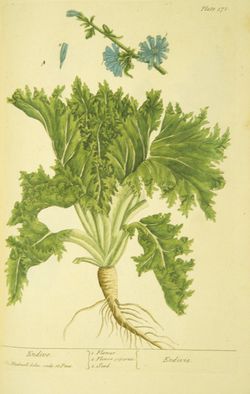Good crops for the beginning gardener
- This page is under construction - JE
What to include for each crop
- Name (in link)
- When to sow or plant
- How to sow or plant
- Soil
- Fertilizers
- Other conditions
- Comments
Beans
- Main article Bean (Phaseolus vulgaris)
Only sow when there's no danger anymore for frost or night frost. For the region where i have my garden (temperate climate, northern hemisphere) this is after May 15. You can sow until half July, depending on the species. Don't add fresh manure to the soil, but beans like a humus-rich soil so you can add some old compost or saw dust to prevent the beans from rotting.
Beans like full sun and dislike cold and wet weather.
Sow the beans 7 per stick or group of plants and keep the five best of them. Cover the seeds with ca 2 cm of moist soil.
Beans growing onto sticks: You may need to help the beans fix to the stick with little ropes. The bean twiners coil anti-clockwise, seen from above.
Pick those beans that are big enough. Picking the beans stimulates the growth of more beans.
Beetroot
- Main article Beetroot
You can sow beetroot directly into the soil. It helps to put the seeds a few days in water to make them germinate faster. You can also sow beets in pots and then plant them out, but because beets have taproots you cannot keep them long in pots. Thin the beets at 15 cm in the row.
Desired pH = 6-6.5 (a bit acid).
Beetroots need to grow in the full sun and don't tolerate shade.
They don't appreciate a lot of nitrogen fertilizer, so don't give them too much compost. However, they do like some potassium added.
Lettuce is a good companion plant for beetroot.
For winter storage harvest beetroot before it begins to freeze. Twist off the foliage with your hands, don't cut it with a knife. When you cut beetroot stems with a knife, the juices in the turnip will bleed out, and not when you twist them off with your hands.
Carrot
- Main article Carrot
Carrots like any soil but rocks will deform them. They also don't like and don't need compost or manure. I always sow them in a field that was composted the year before and where another crop has grown on that compost. They grow well even in soils that are so poor that most other crops won't develop.
Sow summer carrots from February to the end of June. Winter carrots from March to May. Add wet sand to the seeds and keep them a few days like this, then sow the seeds together with the sand. The sand helps you sow regularly and the moist seeds germinate faster. Sow ca 2 cm deep. To find back the line (carrots grow very slowly during the first month or so), you can add some radish seed. I usually plant bulb onions in the lines, each one or two hand widths an onion. This also shows the line and it prevents carrot flies from damaging your crop.
After a few weeks you need to thin the small plants; give winter carrots a bit more space.
Carrots are said to be useful companion plants for tomatoes as they increase tomato production. I haven't tried this out yet.
Carrots grow best in full sun but tolerate some shade.
Carrots tolerate some frost. I usually keep them outside under a sheath of hay until it begins to freeze continually. Dig them out and store the roots without the leaves covered with clean sand in a box in a cellar or other cool place.
Celery
- Main article Celery
The celery of which the leaves are used, leaf celery, is sown in spring in March and later again in September. I usually sow in pots and plant them out later. You can also mix the seeds with moist sand and let them start to germinate before sowing outside. In September you can sow in pots or under glass. You can actually sow through the entire summer, but the plants won't become as big as those sown in March.
Spring celery can be harvested in August-September. Autumn celery from February to April. Cut or pick leaf celery when they are about 15 cm high, but don't cut out the heart so you can harvest again.
Celery root can be pre-sown from February to April and planted out in May and June. Celery root needs longer time to grow and likes a fertile soil.
In the past, celery was grown as a vegetable for winter and early spring. It was perceived as a cleansing tonic. It is used in some weight-loss diets where it provides low-calorie fibers.
Celery is also grown for its seeds. The volatile oil is used in the perfume and pharmaceutical industries. Celery seeds, whole or ground, can be used to season dishes.
Cucumber
- Main article Cucumber
The cucumber originates in India but is now grown around the world. Depending on the cultivar you can grow them in a greenhouse, a cold frame or outside. In April you can sow inside, in May until June 21 also outside.
Cucumbers like humus-rich soil and ample compost. A temperature of 70 F (21 C) when the plant grows up gives stronger plants and better results.
Most varieties have seeds. Male and female flowers grow at the same plant and pollination is required. Professional growers bring hives with honey bees to the fields. If you have too few insects in your own garden you can grow bee plants or spray sugar water to attract them.
Water the plants well. Cucumbers need much water and in dry circumstances the fruits get bitter.
Squeeze off the top after the fourth leaf and the branches again after the third leaf. This stimulates the plant to give more fruits. Harvest them when they are young. This stimulates the plant to form new flowers.
Endive
- Main article Endive
Endive is a member of the chicory genus, of which the leaves are often bitter. You can sow them in March under glass and plant them out in May, or sow outside after June 21 for winter harvest. During the first month of growth, endive should not be exposed to temperatures below 50 F (10 C) or the plants will soon make flowers instead of nice green heads. Seeds sown after June 21 won't make flowers anymore.
The green leaves are rich in vitamin A and C and minerals and can be cooked or used raw in salads. Some gardeners bleach the center leaves by putting a flower pot upside down on the plants a few weeks before harvesting.
Let one or two plants stand to make flowers. You cannot eat these plants but the blue flowers are beautiful.
Fava bean
- Main article Fava bean
Sow fava beans (also called broad beans) in February and March. You can also sow under glass already in late autumn or January. Fava beans can overwinter.
Don't add manure to the soil but some old compost is ok, or sawdust to prevent the beans from rotting. Sow some dill in the same row, they protect against blackfly. Another method against blackfly is to pinch out the tops when the plant begins to blossom. You can stir-fry these tops and they are delicious.
Plant distance in the row 15 cm and between the rows 60 cm. Harvest is from mid June to July. You can grow lettuce between the beans when they are still small.
Fava beans grow in any soil but prefer rich loams. As a legume, they live in a symbiosis with Rhizobium, soil bacteria that fix nitrogen.
Broad beans are an old vegetable and were already eaten in the Mediterranean around 6000 BCE or earlier. Fava beans are often flavored with savory.







